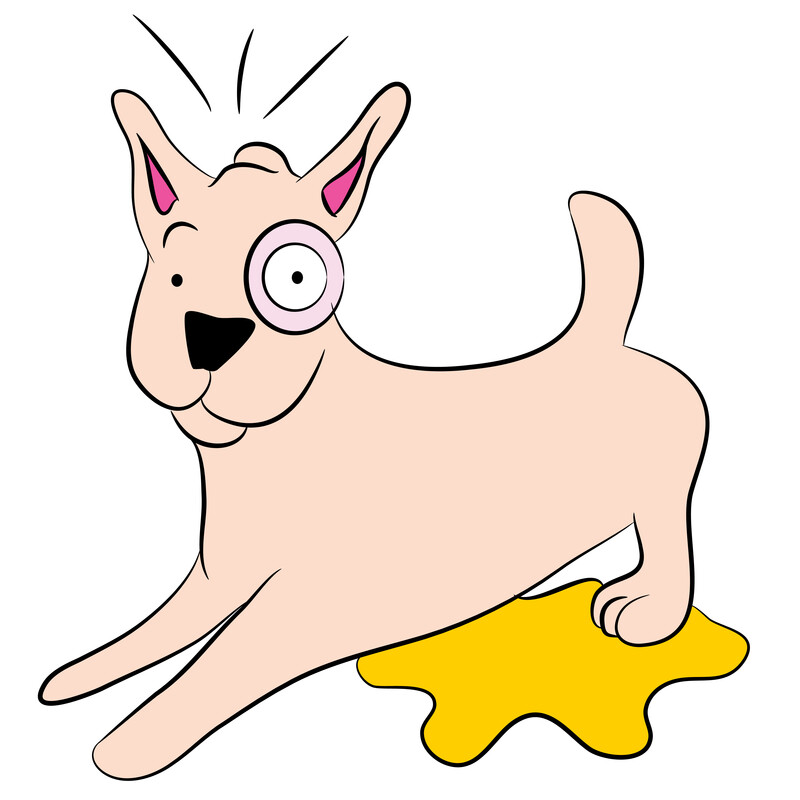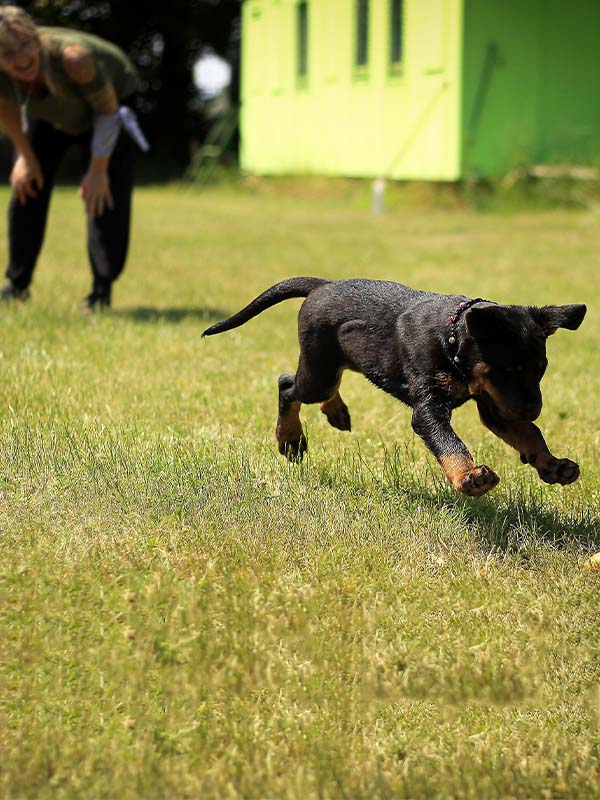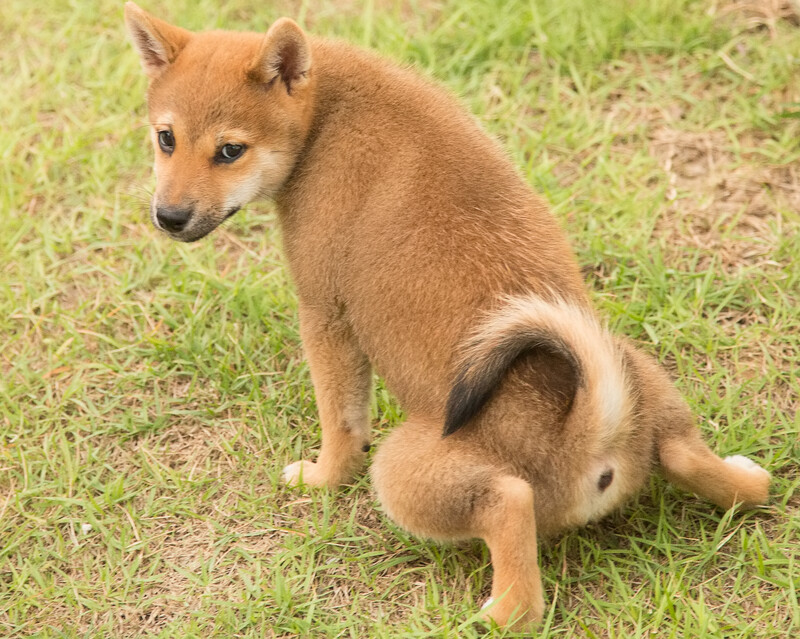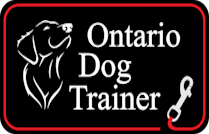Getting Started
 Potty training your puppy can be easy when you follow a few simple steps. Puppies will want to pee and poop wherever they have done so before. Initially, they will not automatically go to your door and ‘ask’ to go outside. How quickly they learn to go to the door to go outside depends on how diligent you are with sticking to a consistent potty schedule to teach them what you want and how they can be successful – and maybe even earn a treat! Your job is to create a schedule of taking your puppy outside to make sure they learn to prefer the outdoors as a toilet – not your carpets!
Potty training your puppy can be easy when you follow a few simple steps. Puppies will want to pee and poop wherever they have done so before. Initially, they will not automatically go to your door and ‘ask’ to go outside. How quickly they learn to go to the door to go outside depends on how diligent you are with sticking to a consistent potty schedule to teach them what you want and how they can be successful – and maybe even earn a treat! Your job is to create a schedule of taking your puppy outside to make sure they learn to prefer the outdoors as a toilet – not your carpets!
TIP #1:Track Your Pup’s Holding Limits
To successfully housetrain your puppy, you need to know how long your pup can wait between potty times. A puppy can usually last between potty breaks for as many hours as age in months plus one, during the day, and 1½ times that length of time overnight.
Example: A puppy 3 months of age can hold for 4 hours during the day
Overnight Holding Limit = 1½ times the Daytime Holding Limit
Example: A puppy 3 months of age can hold for 1½ x 4 = 6 hours overnight
Get everyone in your family involved in teaching your puppy to learn good potty habits. Create a potty schedule and post it in a prominent place so that everyone can keep track of the times when your pup is scheduled for a potty break. It is equally important to keep track of when your pup goes potty to build a potty schedule that works.
TIP #2: Confinement Helps
Whenever you are unable to supervise your puppy with 100% attention, place them in either a short-term or long-term confinement area. BE SURE THAT YOUR PUP IS TIRED FROM PROPER EXERCISE when placed in long-term confinement.
Your puppy can be placed in a short-term confinement area such as a crate for less than its holding limit. The purpose of a crate is to help with potty training and save your sanity while keeping your pup out of trouble. There will be times when you are unable to supervise your puppy and may miss their brief signal that they need to ‘go’. At these times, a crate can be a best friend for you and your puppy!
The crate should be just big enough for your pup to lie down with outstretched limbs, stand up, and turn around easily. It should not be so big that your pup thinks there is enough space for a bedroom and for a toilet area! When you let your pup out of the crate, immediately take them outdoors to their designated ‘potty area’ and praise them for doing business in the right place.
For longer confinement periods that may extend beyond your pup’s holding limit, a bigger area is recommended, with non-absorbent flooring, such as a bathroom, kitchen, or utility room, or ideally, an indoor kennel in a comfortable, well-ventilated basement. The long-term confinement area should have a bed or open crate at one end, and a pile of newspaper or a strip of sod at the opposite end. Your puppy will naturally want to eliminate as far as possible from its bed. If the space you use for long-term confinement happens to have a door that leads to the outdoors, then place the toilet area near that door. This way, your puppy’s toilet area is as close as possible to the ultimate potty destination.
TIP #3: Follow Natural Potty Times
Puppies will naturally have the urge to eliminate after a nap, a meal, a drink, exercise, play, excitement, or time spent in confinement. Give your puppy the opportunity to “go potty” outdoors at these times, even if they occur within your pup’s holding limit.
Take your pup to the same area each time – preferably a grassy place located at the far end of your yard or a distance away from the house. You want to teach your puppy to “go potty” in that same place each time. Eventually, with repetition, your pup will seek out that special area to go to the bathroom.
TIP #4: Make Potty Time an Exciting Time
If you would like your pup to poop promptly when you take it out, teach that a prompt poop is a ticket to a walk around the block – or to do some other exciting job or game with YOU!
TIP #5: Label It
Once the ‘habit’ is established of going potty in a special place and then going for a walk or playing a game, you can add a verbal cue such as “go potty” to tell your pup to poop on command! This will encourage your pup to do their business immediately when outside – and will allow you to leave the stinky poop bag at the house, rather than having to carry it around for much of the walk. If you do the opposite by taking your pup for a walk BEFORE potty in the yard is complete and ending the walk or fun time as soon as potty is complete, your pup will learn to delay pooping so that they can stay longer outside!
TIP #6: Be in the Moment
Punishing your PUP for going potty in the house after it has happened is abuse, not training. If you wait more than a few seconds after your puppy has had an accident before expressing your disapproval, your puppy will not know why it is being punished. If you catch your puppy about to pee or poop in the wrong place you can clap your hands and say “Ah-ah”, and swiftly scoop them up and go to the special place outdoors for your pup to continue the job. Praise your pup when their potty business is ‘finished’ in the proper location.
Welcome to Our Community!
I’m looking forward to seeing you join in the fun on our social media pages! Tap, follow and drop a comment saying hi!
For more great training tips, check out our BLOG.
Follow us on TikTok for more videos like these!
Join our FACEBOOK and INSTAGRAM community for daily content and training tips.
We are constantly posting new videos so make sure to subscribe to our YouTube Channel and ring the bell for the videos that you like!
Do you need help with your new puppy? We LOVE puppies! Visit our website to learn about our Puppy Training Packages. Do you dream of becoming a certified professional dog trainer? To learn if a dog training career is right for you, visit the Dog Trainer T.R.I.B.E Academy
